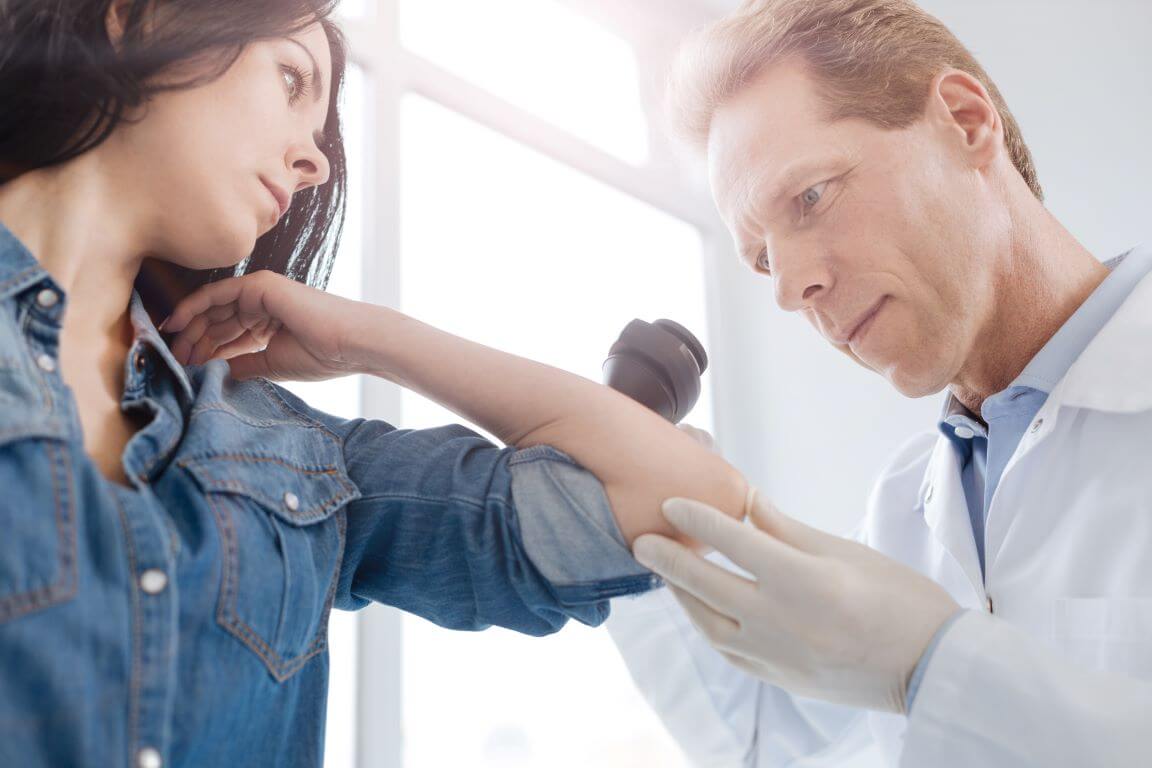Skin cancer is a serious and common health condition that impacts millions of people in the United States each year. According to the Skin Cancer Foundation, 1 in 5 Americans are diagnosed with skin cancer before the age of 70. According to Dr. James Griffith of U.S. Dermatology Partners in Overland Park and Leawood, Kansas, “Skin cancer is extremely prevalent, but with early detection, even the deadliest form of skin cancer, melanoma, has a 99% survival rate after five years. This places a strong importance on regular dermatologic examinations, especially for those who are at higher risk of skin cancer like those with a family history of skin cancer and those who experience frequent or prolonged sun exposure.” In this blog, Dr. Griffith will talk through what skin cancer looks like and how it can be diagnosed in the earliest, most treatable stages.
Variability in Appearance
There are some common skin cancer characteristics you can look for in any type of skin cancer, but symptoms can vary dramatically by the type and stage of cancer. When it comes to the variation in appearance of different types of skin cancer, Dr. Griffith says, “If you notice a new, changing, or spontaneously bleeding lesion on the skin, it’s best to have it examined by a dermatologist. While it may be nothing, it’s better to make sure that’s the case rather than failing to receive a diagnosis when skin cancer is in its more treatable early stages.”
Misconceptions About Skin Cancer
Some of the most common misconceptions about skin cancer that can lead to a missed opportunity for early diagnosis include:
- You only need to wear sunscreen when it’s sunny – Being outside on cloudy days or in cold weather doesn’t mean the sun’s UV rays won’t damage your skin. It’s important to wear sunscreen and practice photoprotective behaviors every day.
- Skin cancer always develops immediately after sun damage – While some forms of skin cancer may develop quickly after sun damage is sustained, most skin cancers develop as a result of the cumulative effects of sun exposure over many years. So, it’s essential to protect the skin every time it’s exposed to sunlight.
- There’s no point in wearing sunscreen if I already had skin cancer – A past skin cancer diagnosis doesn’t mean you’re too late to protect your skin from additional damage. You can help prevent future skin cancer from developing by protecting your skin from additional damage, leading to skin cancer.
- Exposure to sunlight is the only cause of skin cancer – While exposure to the sun’s UV rays is one of the leading causes of skin cancer, it is not the only cause, so even if you don’t go out in the sun often, you may still be at risk for skin cancer.
- Skin cancers are easy to recognize – While some skin cancers can be obvious and easy to recognize, many skin cancers initially are subtle, requiring the trained eye of a dermatologist to be caught early when the skin cancer is easiest to treat.
Skin Tone and Cancer Visibility
While skin cancer is more prevalent among those with pale skin, anyone can develop skin cancer. However, the symptoms may look a little different and stem from causes other than sun exposure. Specifically, people of color are much more susceptible to skin cancers that develop on the fingernails, toenails, groin, buttocks, and mouth. In addition to more frequently developing skin cancer in areas that are not exposed to sunlight, people of color may also see slightly different general symptoms. Some common skin cancer symptoms seen in skin of color include:
- Dark lines underneath or around nail beds
- Sores that don’t heal or come back after healing
- Sores that develop in a place where a scar is located
- Bleeding or itching skin
- Darker patches of skin
- New growths that look different from other spots on the skin
Hidden Areas and Overlooked Spots
One of the reasons that skin cancer may go undiagnosed is if it develops in hard-to-see areas of the body. When performing skin cancer self-exams, it’s important to take the time to carefully examine all areas of the skin, including the harder-to-examine places like the scalp, the skin under a beard, the skin under a tattoo, fingernails, buttocks, genitals, toenails, and bottoms of feet. You can use a flashlight, hand mirror, and other resources to get a closer look at these areas and make note of any irregularities. Combining self-skin exams with intermittent professional examinations by your dermatologist is the best way to find skin cancers early when they are easiest to treat or in hidden areas.
Early Signs and Symptoms
One of the easiest ways to remember what to look for during a skin cancer self-exam is to keep your ABCDEs in mind:
- A – Asymmetry – a mole or lesion is different on one side than another.
- B – Border – the border is scalloped or uneven rather than smooth.
- C – Color – the coloring differs from other moles or has multiple colors within one lesion.
- D – Diameter – moles or lesions that are bigger around than a pencil eraser.
- E – Evolution – a lesion or mole that is changing quickly.
Other early warning signs of skin cancer include:
- Pink or gray-black spots that do not go away over two months. (Red is normally fine).
- Recurrent or spontaneously bleeding lesions.
- Dome-shaped lumps or growths under the skin.
- Sores that don’t heal.
- Dark spots under fingernails or toenails.
- Gritty-feeling, scaly growths of skin.
- Itchy lesions.
The Role of Regular Skin Checkups
According to Dr. Griffith, “Regular skin cancer checkups are an essential part of keeping skin healthy, and they are especially important to ensure early skin cancer detection. Even with regular self-checks, there is a risk that you may miss an early warning sign of skin cancer. What you may overlook, even with an educated eye, a dermatologist will notice. That means they can examine skin carefully and provide early detection and intervention.”
Advancements in Skin Cancer Detection & Treatment
There have been numerous advancements in skin cancer detection and treatment in the past few years, including:
- Genomic Testing – used for melanoma and squamous cell carcinomas in advanced stages. It gives dermatologists and oncologists a greater level of detail about the patient’s prognosis, allowing for more effective treatment.
- Advances in Imaging Technology – full-body imaging scanners used for melanoma screening and management. Most skin cancer is diagnosed through visual examination by a dermatologist both on the skin and under the microscope, following a biopsy.
- Artificial Intelligence (AI) – used to diagnose melanoma and other skin cancer. A UK study presented at the European Academy of Dermatology and Venereology (EADV) Congress 2023 showed that AI technology was able to accurately diagnose 100% of melanoma cases, 99.5% of all skin cancers, and 92.5% of pre-cancerous lesions. While the use of AI technology for cancer diagnosis is still in the research phases, this advancement in technology may make diagnosis and treatment easier in the future and increase access to appropriate care.
Remember the Importance of Early Detection
In conclusion, Dr. Griffith reminds us, “Most forms of skin cancer are treatable in the early stages, so it’s always best to alert your dermatologist as soon as you notice any potential warning signs of skin cancer. To help minimize the risk for skin cancer-related deaths, it’s important to perform skin self-exams every month and visit a professional for an examination once a year.”
Schedule a Skin Cancer Screening
Concerned about skin cancer? Schedule a professional skin evaluation with our experienced dermatologists today for peace of mind. During an annual skin cancer assessment and skin exam, our dermatologists will carefully evaluate your skin for signs of skin cancer and other skin health concerns. They can answer questions about your skin health, provide skincare recommendations, and generally guide you to achieve and maintain healthier skin. Whenever you’re ready to get started, simply take a few moments to complete our online scheduling request form. Once a local office receives your appointment request, they’ll be in touch to finalize the details of your visit.
Find a location near me
or


